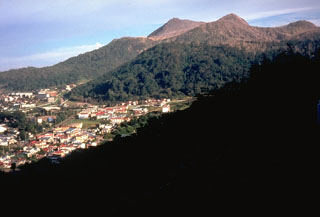Report on Toya (Japan) — February 1978
Scientific Event Alert Network Bulletin, vol. 3, no. 2 (February 1978)
Managing Editor: David Squires.
Toya (Japan) Earthquake frequency increases; new cryptodome uplift slows
Please cite this report as:
Global Volcanism Program, 1978. Report on Toya (Japan) (Squires, D., ed.). Scientific Event Alert Network Bulletin, 3:2. Smithsonian Institution. https://doi.org/10.5479/si.GVP.SEAN197802-285030
Toya
Japan
42.544°N, 140.839°E; summit elev. 733 m
All times are local (unless otherwise noted)
Weak steaming from vents and fissures on the slopes of . . . Ko-Usu and the new cryptodome NE of Ko-Usu continued during January. Steam clouds rose a maximum of 400 m above the vents. The rate of uplift of the new cryptodome briefly increased in late December to 38 cm/day (from 35 cm/day in mid-December), then declined to 31 cm/day in early January and to 26 cm/day by the end of the month. A team from Hokkaido University measured its summit altitude at 568 m in early January [compared to about 490 m altitude before the August 1977 eruption].
Daily earthquake frequency gradually increased at the end of January, and by late February had returned to the September rate. Epicentral distribution, according to Hokkaido University geophysicists, was unchanged, concentrated beneath Ko-Usu and the N portion of the somma, to slightly N of the somma.
Geological Summary. Usuzan, one of Hokkaido's most well-known volcanoes, is a small stratovolcano located astride the southern topographic rim of the 110,000-year-old Toya caldera. The center of the 10-km-wide, lake-filled caldera contains Nakajima, a group of forested Pleistocene andesitic lava domes. The summit of the basaltic-to-andesitic edifice of Usu is cut by a somma formed about 20-30,000 years ago when collapse of the volcano produced a debris avalanche that reached the sea. Dacitic domes erupted along two NW-SE-trending lines fill and flank the summit caldera. Three of these domes, O-Usu, Ko-Usu and Showashinzan, along with seven crypto-domes, were erupted during historical time. The 1663 eruption of Usu was one of the largest in Hokkaido during historical time. The war-time growth of Showashinzan from 1943-45 was painstakingly documented by the local postmaster, who created the first detailed record of growth of a lava dome.
Information Contacts: JMA, Tokyo; D. Shackelford, CA.

